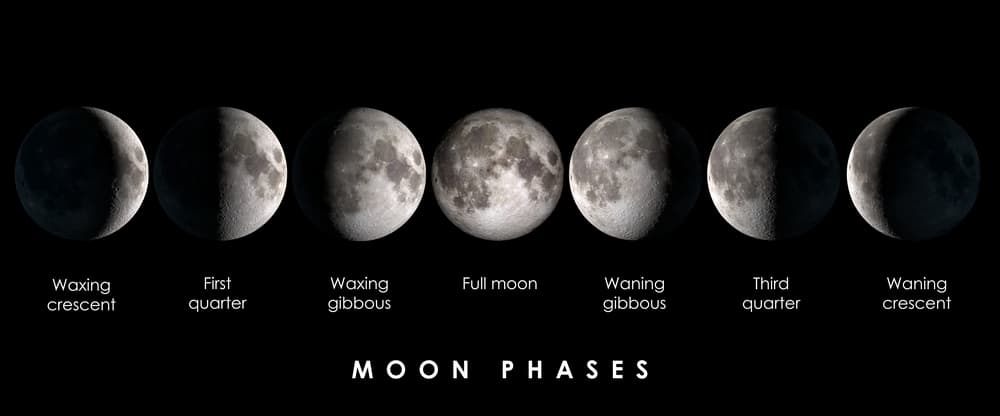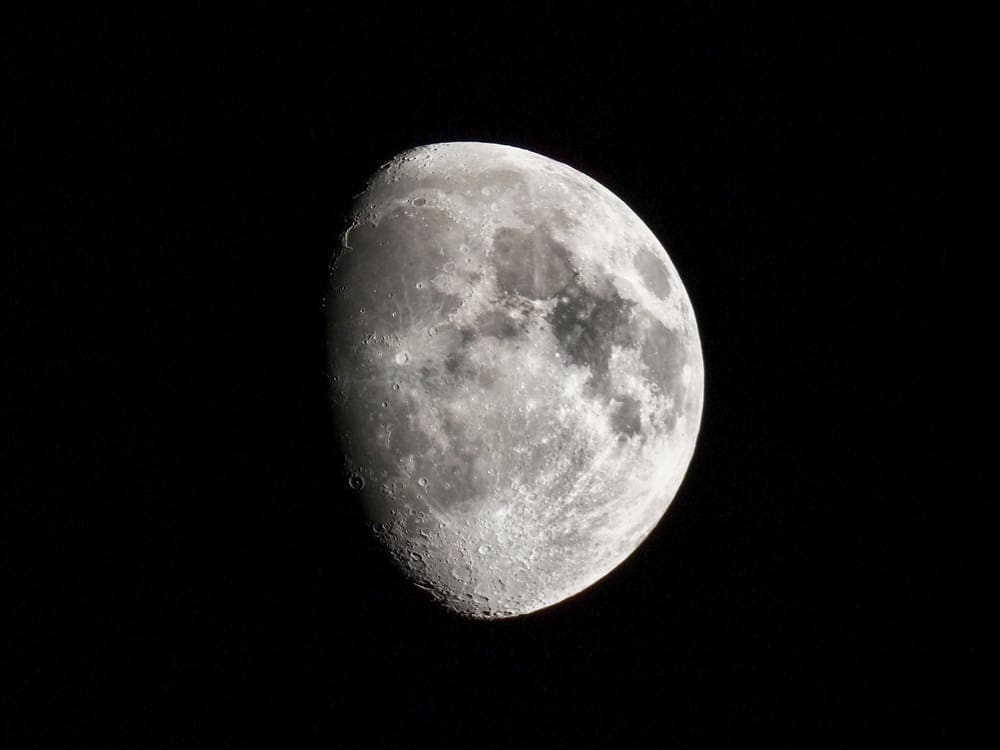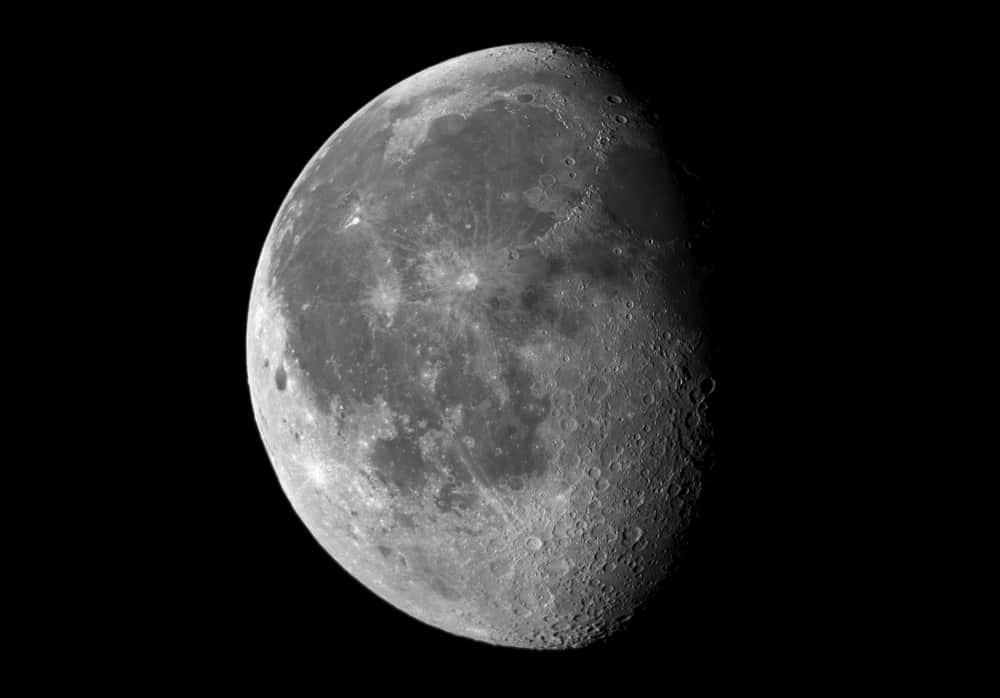What is a gibbous moon? Definition & explanations
Last Updated: 1st January 2021
The gibbous moon is one of the various phases that the Moon goes through during its monthly lunar cycle. The moon is said to be in the gibbous phase when it can be seen from Earth with more than half but not all of the apparent disk illuminated. This phase actually happens twice each month during the waxing gibbous phase and the waning gibbous phase.

Table of Contents
What is a waxing gibbous moon?
To wax means to “to grow larger or increase”. In the case of the moon, this means that the area on which the sun projects its light onto the lunar surface is growing every day.
The waxing gibbous moon is the period of time where the moon’s illuminated area grows from 50.1% to 99.9% from our point of view on Earth. It begins right after the first quarter moon and lasts until the full moon starts. This intermediate phase of the moon lasts about 7 days.
If you go out at night during the seven days of the waxing gibbous phase, you will notice that the moonlight becomes brighter each night, enough to allow you to find your way around without lampposts and even cast shadows.

A beautiful waxing moon in the night sky
What is a waning gibbous moon?
To wane means to “to decrease in size”. In the case of the moon, it means that the area on which the sun projects its light on the lunar surface decreases every day.
The waning gibbous moon is the period of time where the moon’s illuminated area reduces from 99.9% to 50.1% from our point of view on Earth. It starts right after the full moon and lasts until the last quarter begins. This intermediate phase of the moon lasts about 7 days.
A waning moon rises in the east after sunset and set in the west after dawn. If you go out at night during the seven days of the waning gibbous phase, you will notice that the moonlight becomes dimmer each night.

A waning gibbous moon slowly fades away
When can you see a gibbous moon?
The moon goes through its 8 phases in 29.5 days, which is called the synodic month. The synodic month is not in sync with our month since they have 30 or 31 days. This means that the phases of the moon happen at a different time every month. So in order to know when the next gibbous moon will appear, you may need to use a website that provides an up-to-date lunar calendar such as https://moonphases.co.uk
That said, one can easily recognize which phase the moon is going through by observing it in the sky. The moon is waxing when the illuminated area is getting bigger every night and it is waning when said illuminated is getting smaller. You can either observe the moon for a few days to see if it becomes bigger or smaller. Or you may use an astronomy application to quickly determine if the moon is waxing or waning.
Observing a gibbous moon through a telescope or binoculars
You may think that the best time to observe the moon is when it is full. This is not quite the case, as a full moon will be very bright in the eyepiece of your telescope or astronomical binoculars. It will be difficult to see the detailed characteristics of the moon’s surface without a lunar filter. The ideal time to observe many moon craters in great detail is during the waning or the waxing gibbous phases.
The “terminator”, the dividing line between day and night on the moon’s surface provides the best view. It creates a high-contrast view thanks to the light rays coming from the sun that bounces off the craters, giving them a 3D effect that reveals a great amount of detail. You can study the moon’s surface during the waning and waxing moon phase for about two weeks every month.
Can a gibbous moon influence plant growth?
In the past few years, there has been an increasing number of published articles and books that claims that moonlight can affect plant growth. They explain that each phase of the moon has different benefits for seed germination, plant growth and flowering. A waxing gibbous moon supposedly stimulates leaf growth while a waning gibbous moon supposedly stimulates plant roots.
And while it’s not an entirely implausible fact, there is no scientific evidence that a gibbous moon can affect plants that way.
The meaning of the gibbous moon in astrology
Astrology is one of the fastest redeveloping modern industries to date. Spiritually, pagans and modern witch astrologers alike find the gibbous moon phases a perfect time for action. Whether this is banishing, cleansing and shadow work (with the Waning moon) or if it is growth, attraction and development work (with the Waxing moon) they believe that the moon phases influence their ability to perform certain rituals and rites.
The timing of each moon phase has a great impact on their outcomes, so now many of them use almanacs, planners and diaries to ensure they have the correct moon phase for their task/intentions. This is not to say “all pagans and modern witches believe this” but it is a commonality accepted across this demographic found in many books, apps and readings.
Frequently Asked Questions
How do you tell if a moon is waxing or waning?
You can tell if the moon is waxing or waning by looking for the shadow part of the moon. In the northern hemisphere, the shadowed region is on the left if the moon is waxing or on the right, if it is waning. If you live in the southern hemisphere, it will be the other way around: the moon is waxing if the shadowed region is on the left or waning it is on the right.
What comes first waning or waxing?
The moon is waxing first, as it’s illuminated area grows larger until it reaches the full moon phase. After about three days, the moon starts waning as its illuminated area decreases.
How long do the gibbous phases of the moon last?
The two gibbous phases last for about 14 days per synodic month. Seven days for the waxing phase and seven days for the waning phase.
Why is there no gibbous moon phase symbols in calendars?
The two gibbous moon phases (waxing and waning) are not represented in the calendars because they are not primary phases. Only the 4 main moon phases are shown in calendars.

Welcome to StarLust.org
Hey! I’m Tom Urbain, the founder of StarLust.org. I have been obsessed with space from a very young age. When I’m not binge-watching space documentaries, movies or TV shows, I can be found in my backyard, carefully collimating my telescope… ready to observe the universe!
Recommended Reading
This moon-related story is part of our collection of astronomy articles. If this piece sparked your interest, you’re sure to enjoy the fascinating insights offered in our subsequent articles.
Moon exploration has come a long way since Russia’s first lunar probe reached the Moon…
Let’s talk about the people who have paved the way to the moon and made space exploration possible.
Depending on the atmospheric conditions in your area, you may see the moon in different colors. Here’s why.
The moon that we are most familiar with is white in color. However, it sometimes takes on a majestic red appearance… Here’s why.
